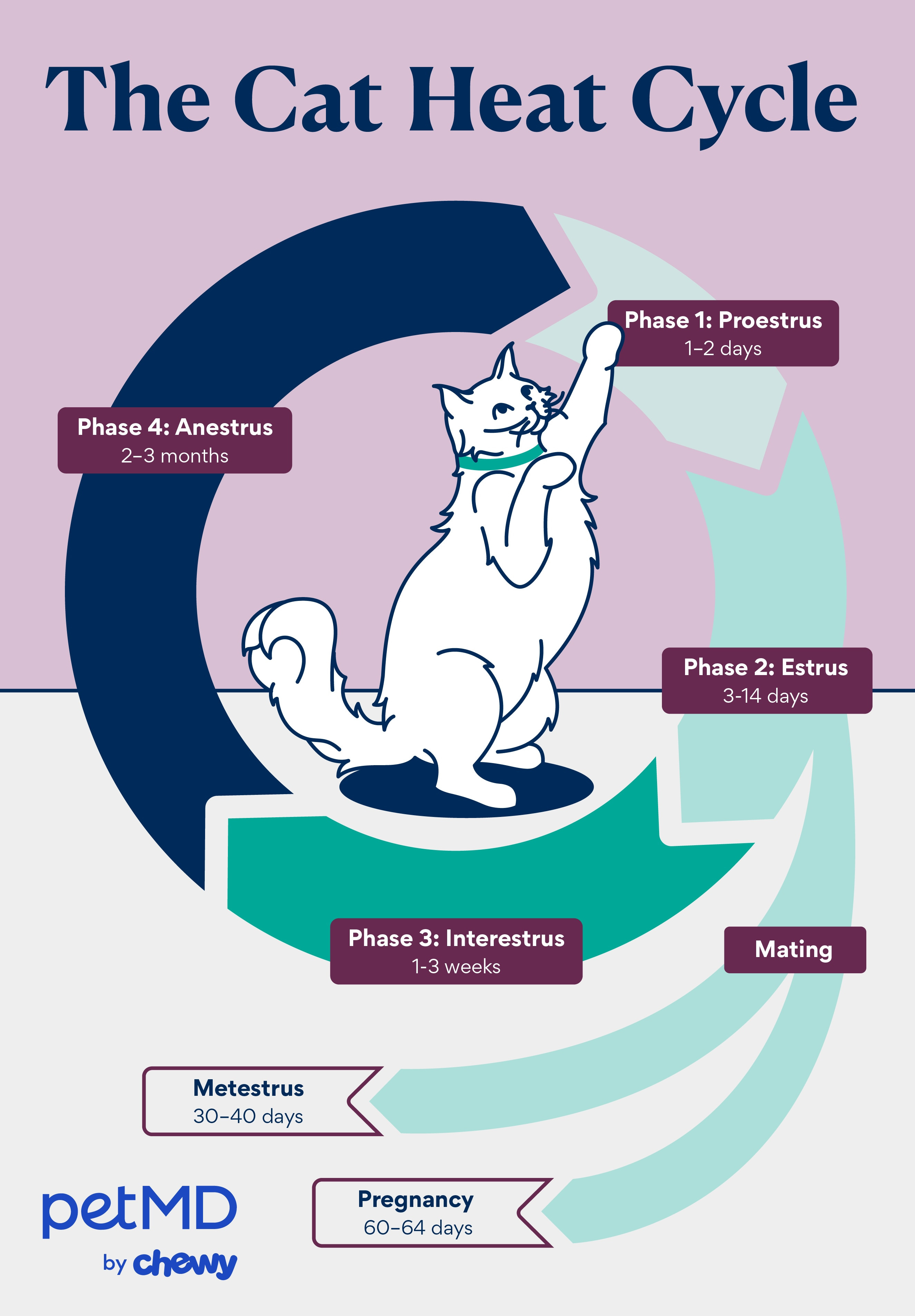For those unfamiliar with feline reproductive cycles, understanding when a female cat, or queen, is in heat can be crucial, especially if you haven’t spayed your pet. Unlike dogs and humans, the estrous cycle in cats presents unique characteristics. Recognizing the signs of a cat in heat is essential for responsible pet ownership, whether you’re considering breeding or simply want to understand your cat’s behavior. This guide will walk you through everything you need to know about a cat’s heat cycle and how to identify when your feline friend is experiencing it.
When Do Cats Go Into Heat?
The age at which a cat first experiences heat can vary, but generally, most cats start their heat cycles between 5 to 9 months old. However, some kittens may begin as early as 3-4 months, while others might not start until they are around 18 months of age. Several factors influence this timing, including breed, weight, and even the time of year. Cats are seasonal breeders, meaning their cycles are heavily influenced by daylight hours.
Understanding the Cat Heat Cycle Stages
 Cat in heat illustration showing behavioral signsThe feline estrous cycle is comprised of four distinct stages, each with its own hormonal and behavioral characteristics. Understanding these stages is key to knowing if your cat is in heat.
Cat in heat illustration showing behavioral signsThe feline estrous cycle is comprised of four distinct stages, each with its own hormonal and behavioral characteristics. Understanding these stages is key to knowing if your cat is in heat.
Proestrus
Proestrus marks the beginning of the cycle when estrogen levels start to increase in the cat’s body. This initial phase typically lasts for just one to two days. During proestrus, you might not notice any overt symptoms in your cat. However, male cats may sense the hormonal changes and show increased interest in the female, although she will not yet be receptive to mating.
Estrus
Estrus is the most recognizable stage of the heat cycle and what most people refer to when they say a cat is “in heat.” This phase generally lasts about a week, but it can range from three to as long as 14 days. During estrus, a female cat exhibits significant behavioral changes. She becomes receptive to mating and will actively seek out male cats.
Common signs of estrus include:
- Increased Affection: Your cat may become excessively affectionate, seeking attention from you and other pets in the household more than usual.
- Excessive Vocalization: Cats in heat often become very vocal, producing loud meows or caterwauling sounds, which serve to attract male cats.
- Restlessness: She may appear restless, pacing around the house and seeming unable to settle down.
- Posturing: You might notice your cat adopting a mating posture, known as lordosis, where she lowers her front body, raises her hindquarters, and treads her back paws.
Interestrus or Metestrus
After estrus, there are two possible phases depending on whether ovulation occurred. Cats are induced ovulators, meaning they typically only release eggs after mating.
- Metestrus: If mating occurs and ovulation is triggered, but fertilization does not happen, the cat enters metestrus. This phase involves a pause in the cycle and lasts for about 30–40 days.
- Interestrus: If the cat does not mate or ovulate during estrus, she will go into interestrus. This is a period between heat cycles lasting one to three weeks, where in-heat behaviors subside before the cycle potentially restarts with proestrus.
Anestrus
Anestrus is a period of sexual inactivity. Cats are seasonal breeders, and anestrus usually occurs during the shorter daylight months, typically for two to three months in the late fall and winter. During anestrus, there is minimal hormonal activity, and the cat does not cycle.
Recognizing the Signs: How to Know If Your Cat Is In Heat
Unlike dogs, cats do not exhibit vaginal bleeding during their heat cycle. Therefore, recognizing a cat in heat relies primarily on observing behavioral changes. A cat in heat may display several noticeable symptoms:
- Overwhelmingly Affectionate Behavior: Your cat might become unusually clingy, rubbing against furniture, walls, and your legs more frequently. This is part of their scent-marking behavior and seeking attention.
- Excessive Vocalization: Expect increased meowing, yowling, and caterwauling. These sounds are intended to attract male cats from a distance.
- Reduced Appetite: Some cats may experience a decrease in appetite while in heat, though this is not always the case.
- Restlessness and Agitation: Your cat may seem agitated, unable to get comfortable, and constantly moving around.
- Urinating Outside the Litter Box: Though less common, some cats in heat may urinate more frequently or inappropriately outside their litter box as a way to mark territory and signal their reproductive status.
It’s important to note that these behavioral changes can sometimes be intense, leading some pet owners to worry that their cat is in pain. While the heat cycle itself isn’t painful, the hormonal changes can cause significant behavioral shifts. If you’re concerned about sudden behavioral changes in your cat, consulting with your veterinarian is always recommended.
What To Do When Your Cat Is In Heat
If your cat is in heat and you do not wish to breed her, the most important step is to prevent unwanted pregnancy by keeping her indoors and away from unneutered male cats. Beyond this, there are generally no specific lifestyle changes needed for a cat in heat.
However, it’s wise to monitor the duration and frequency of her heat cycles. Be aware of potential complications such as pseudopregnancy (false pregnancy) or mucometra (accumulation of mucus in the uterus). Pyometra, a serious uterine infection, is a more severe risk, particularly for older, unspayed cats, and requires immediate veterinary attention.
Seek veterinary care if your cat exhibits any of these symptoms during or after her heat cycle:
- Lethargy or weakness
- Loss of appetite
- Fever
- Vaginal discharge (especially if it is pus-like or bloody)
- Swollen abdomen
Preventing Heat Cycles in Cats
Spaying, which involves the surgical removal of the uterus and ovaries, is the only definitive way to prevent heat cycles and pregnancy in female cats. Unless you are a responsible breeder with a planned breeding program, spaying is highly recommended.
Spaying offers significant health benefits, reducing the risks of:
- Pyometra
- Pseudopregnancy
- Mammary cancer
- Ovarian cancer
There are no health advantages to allowing a cat to experience a heat cycle before spaying. Veterinarians often recommend spaying kittens at around 5-6 months of age, ideally before their first heat cycle, to prevent these cycles entirely and provide optimal health benefits.
Cats in Heat FAQs
Do cats bleed when in heat?
No, cats should not bleed during their heat cycle. Any vaginal bleeding is abnormal and warrants an immediate veterinary visit. A clear vaginal discharge can sometimes occur during proestrus, but blood is not normal.
Can you spay a cat in heat?
Yes, it is generally safe to spay a cat even while she is in heat. Waiting for anestrus to perform a spay surgery would prolong the risks and inconvenience of heat cycles.
Do male cats go into heat?
No, male cats do not experience heat cycles. However, unneutered males are always capable of mating with females and may be particularly drawn to female cats in heat.
How many days is a cat in heat?
The estrus phase, or the primary “in heat” phase with behavioral signs, typically lasts for about a week, with a range of 3 to 14 days.
How do I know if my cat is in heat?
If you suspect your cat is in heat, observe her behavior for signs like increased vocalization, affection, and restlessness. Consult with your veterinarian for confirmation and guidance.
WRITTEN BY
Jamie Lovejoy, DVM
Veterinarian


